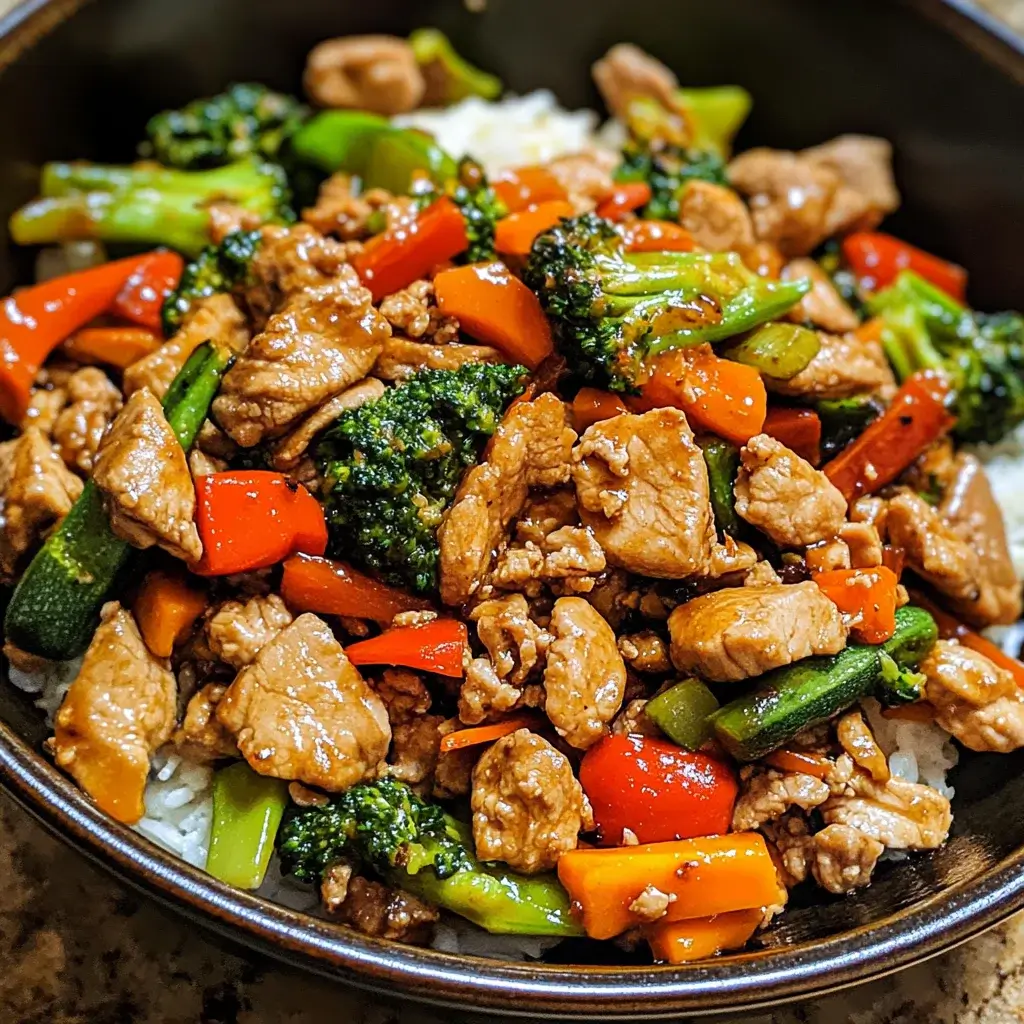There are some nights when dinner needs to be fast, healthy, and something the whole family will actually eat without complaint. That used to feel like an impossible trifecta in our house, especially on busy weeknights filled with homework, after-school activities, and general chaos. Then, I stumbled upon the magic of the stir-fry, specifically this Turkey and Veggie Stir Fry. The first time I made it, I was skeptical. Would the kids eat the veggies? Would turkey be flavorful enough? The aroma filled the kitchen – garlic, ginger, soy sauce – and drew everyone in. To my absolute delight, plates were cleaned! My husband, usually a red meat enthusiast, commented on how light yet satisfying it was. My pickiest eater actually asked for more broccoli (a true miracle!). Since then, this recipe has become a cornerstone of our weekly meal rotation. It’s incredibly versatile, forgiving if you need to swap out a vegetable, and consistently delivers a delicious, nutritious meal in under 30 minutes. It’s proof that healthy eating doesn’t have to be bland or time-consuming, and it brings a satisfying sense of accomplishment to serve a dish that’s both good for your family and genuinely enjoyed by them. This isn’t just a recipe; it’s a weeknight lifesaver.
Ingredients
Here’s what you’ll need to create this vibrant and flavorful Turkey and Veggie Stir Fry. Each component plays a role in building layers of taste and texture for a perfectly balanced dish.
- 1 lb Boneless, Skinless Turkey Breast or Tenderloin: Cut into thin, bite-sized strips (about 1/4 inch thick). Using lean turkey breast keeps the dish light and healthy, providing excellent protein. Ensure it’s sliced against the grain for maximum tenderness. Alternatively, ground turkey can be used for a different texture.
- 1 tablespoon Cornstarch: Used to coat the turkey, creating a light, velvety texture and helping it brown beautifully while slightly thickening the sauce later.
- 1 tablespoon Soy Sauce (Low Sodium recommended): Part of the turkey marinade, adding savory depth (umami) right from the start. Low sodium helps control the saltiness.
- 1 tablespoon Sesame Oil (Toasted preferred): Divided use – half for the turkey marinade, adding a nutty aroma, and half reserved for finishing the dish or cooking. Toasted sesame oil has a much richer flavor than regular.
- 2 tablespoons High-Heat Cooking Oil: Such as avocado, canola, grapeseed, or peanut oil. Needed for stir-frying at high temperatures without smoking excessively. Olive oil is generally not recommended for high-heat stir-frying.
- 1 large Onion: Thinly sliced or roughly chopped. Forms the aromatic base of the stir-fry, providing a subtle sweetness when cooked. Yellow or white onions work well.
- 2-3 cloves Garlic: Minced finely. Essential for its pungent, savory flavor that permeates the entire dish. Fresh garlic is highly recommended over powder.
- 1 tablespoon Ginger: Freshly grated or minced. Adds a warm, zesty spice that cuts through the richness and brightens the flavors. Again, fresh ginger offers superior flavor.
- 1 large Red Bell Pepper: Stemmed, seeded, and cut into 1-inch pieces or thin strips. Adds sweetness, vibrant color, and a good dose of Vitamin C.
- 1 large Green Bell Pepper: Stemmed, seeded, and cut into 1-inch pieces or thin strips. Provides a slightly less sweet, more vegetal flavor contrast and more color.
- 1 large Carrot: Peeled and thinly sliced on the diagonal (or julienned). Adds crunch, sweetness, and color. Slicing thinly ensures it cooks quickly.
- 1 head Broccoli: Cut into small florets (about 1-1.5 inches). A stir-fry classic, adding earthy flavor, texture, and significant nutritional value. Make sure florets are similar in size for even cooking.
- 1/2 cup Snow Peas or Snap Peas: Trimmed. Add a delightful crispness, slight sweetness, and bright green color. They cook very quickly.
- Stir-Fry Sauce:
- 1/3 cup Low Sodium Chicken Broth or Vegetable Broth: Forms the liquid base of the sauce, adding flavor without excessive salt.
- 1/4 cup Low Sodium Soy Sauce: The primary savory and umami element of the sauce. Tamari can be used for a gluten-free option.
- 1 tablespoon Rice Vinegar: Adds a gentle tanginess that balances the savory and sweet notes. Apple cider vinegar can be a substitute in a pinch.
- 1 tablespoon Honey or Maple Syrup: Provides a touch of sweetness to balance the soy sauce and vinegar. Brown sugar can also be used. Adjust to your preference.
- 1 tablespoon Cornstarch: Mixed with a little cold water or broth (slurry) to thicken the sauce towards the end of cooking.
- 1 teaspoon Toasted Sesame Oil: Added at the end for its distinct nutty aroma and flavor.
- (Optional) 1/2 teaspoon Red Pepper Flakes or a dash of Sriracha: For those who enjoy a little heat. Add according to your spice tolerance.
- Optional Garnishes: Toasted sesame seeds, sliced green onions (scallions), chopped cilantro. These add freshness, texture, and visual appeal right before serving.
Instructions
Follow these steps carefully for a perfectly cooked, flavorful Turkey and Veggie Stir Fry. The key is high heat and quick cooking!
- Prepare the Turkey: Pat the turkey strips dry with paper towels (this helps them brown better). In a medium bowl, toss the turkey strips with 1 tablespoon of cornstarch, 1 tablespoon of soy sauce, and 1/2 tablespoon of toasted sesame oil. Mix well to ensure every piece is coated. Let it marinate for at least 10-15 minutes at room temperature while you prepare the vegetables and sauce. This brief marination adds flavor and helps tenderize the turkey.
- Prepare Vegetables & Aromatics: Wash, chop, and slice all your vegetables (onion, bell peppers, carrot, broccoli, snow peas) and aromatics (garlic, ginger). Keep them in separate piles or bowls near your cooking station (mise en place). This is crucial for stir-frying, as the cooking process is very fast. Having everything ready prevents burning. Ensure pieces are relatively uniform in size for even cooking.
- Mix the Stir-Fry Sauce: In a small bowl or liquid measuring cup, whisk together the chicken or vegetable broth, 1/4 cup low sodium soy sauce, rice vinegar, honey or maple syrup, and the remaining 1 teaspoon of toasted sesame oil. If using red pepper flakes or Sriracha, add them here. Set aside. In a separate tiny bowl, whisk the 1 tablespoon of cornstarch with 2 tablespoons of cold water or broth until smooth – this is your cornstarch slurry for thickening later. Mixing cornstarch with cold liquid prevents lumps.
- Preheat Your Wok or Pan: Place a large wok or heavy-bottomed skillet (cast iron works well) over high heat. Let it get properly hot – a drop of water should evaporate almost instantly. This high heat is essential for achieving the characteristic “wok hei” (breath of the wok) flavor and preventing steaming.
- Cook the Turkey: Add 1 tablespoon of the high-heat cooking oil to the hot wok. Swirl to coat the bottom. Carefully add the marinated turkey strips in a single layer, being careful not to overcrowd the pan (cook in batches if necessary). Let the turkey sear undisturbed for 1-2 minutes until nicely browned on one side. Then, stir-fry, tossing frequently, for another 2-4 minutes, or until the turkey is cooked through and opaque. Remove the cooked turkey from the wok with a slotted spoon and set aside on a clean plate.
- Stir-Fry the Harder Vegetables: Add the remaining 1 tablespoon of high-heat cooking oil to the wok (if needed). Add the onions and carrots. Stir-fry for 2-3 minutes until the onions start to soften and the carrots become slightly tender-crisp. Keep tossing constantly.
- Add Aromatics and Remaining Vegetables: Push the onions and carrots to the side of the wok. Add the minced garlic and grated ginger to the center and stir-fry for about 30 seconds until fragrant – be careful not to burn the garlic. Then, add the bell peppers and broccoli florets. Stir-fry everything together for another 3-5 minutes. The vegetables should be vibrant and tender-crisp, not mushy. If the pan seems too dry, you can add a tablespoon of water or broth to help steam the broccoli slightly.
- Add Softer Vegetables: Add the snow peas or snap peas to the wok. Stir-fry for just 1-2 minutes more. They cook very quickly and you want them to retain their bright color and snap.
- Combine and Sauce: Return the cooked turkey to the wok with the vegetables. Give the prepared stir-fry sauce a quick whisk (as the ingredients might have settled) and pour it over the turkey and vegetables. Bring the sauce to a simmer, tossing everything gently to coat.
- Thicken the Sauce: Give the cornstarch slurry another quick stir and pour it into the simmering sauce while stirring constantly. Continue to cook and stir for about 30 seconds to 1 minute, until the sauce thickens to your desired consistency, coating the turkey and vegetables nicely. Be mindful not to over-thicken; it should be glossy, not gloopy.
- Finish and Serve: Remove the wok from the heat. Stir in the remaining 1/2 tablespoon of toasted sesame oil, if desired, for an extra burst of nutty aroma. Taste and adjust seasoning if necessary (more soy sauce for saltiness, a touch more honey for sweetness, or vinegar for tang). Serve immediately over your choice of base (like rice or noodles), garnished with toasted sesame seeds, sliced green onions, or cilantro, if using.
Nutrition Facts
This recipe yields approximately 4 servings. The nutritional information provided is an estimate and can vary based on specific ingredients and portion sizes used.
- Servings: 4
- Calories per serving: Approximately 350-450 kcal (excluding rice or noodles). This makes it a relatively low-calorie meal packed with nutrients, suitable for a healthy eating plan.
- Protein: High (approx. 30-35g per serving). Primarily from the lean turkey breast, protein is crucial for muscle building and repair, satiety (feeling full), and overall body function.
- Fiber: Good Source (approx. 5-8g per serving). Derived mainly from the abundance of vegetables like broccoli, carrots, and peppers. Fiber aids digestion, helps regulate blood sugar, and contributes to fullness.
- Sodium: Moderate (approx. 600-800mg per serving when using low-sodium soy sauce). Stir-fries can be high in sodium due to soy sauce. Using low-sodium versions and controlling added salt helps manage intake. Be mindful of this if you are on a sodium-restricted diet.
- Vitamins & Minerals: Rich in various micronutrients. Notably high in Vitamin C (from bell peppers and broccoli), Vitamin A (from carrots), and B vitamins (from turkey and veggies), supporting immune function, vision, energy metabolism, and more.
Preparation Time
Enjoy this delicious meal without spending hours in the kitchen!
- Prep Time: 15-20 minutes. This involves washing and chopping the vegetables, mincing garlic and ginger, slicing the turkey, and mixing the sauce. Using pre-cut vegetables or a food processor can shorten this time. Efficient mise en place is key.
- Cook Time: 10-15 minutes. Stir-frying is a fast cooking method that relies on high heat. The actual time spent at the stove is relatively short once everything is prepped.
- Total Time: 25-35 minutes. From starting your prep to serving the finished dish, this Turkey and Veggie Stir Fry is a perfect solution for quick and healthy weeknight dinners or lunches.
How to Serve
Serving this Turkey and Veggie Stir Fry is flexible. Here are some popular and delicious ways to present it:
- Classic Rice Base:
- Serve hot over a bed of fluffy steamed white rice (like Jasmine or Basmati) to soak up the savory sauce.
- Opt for brown rice for added fiber and a nuttier flavor.
- Consider coconut rice for a subtle tropical twist.
- Noodle Options:
- Toss the stir-fry directly with cooked noodles like egg noodles, udon noodles, soba noodles (buckwheat), or even whole wheat spaghetti for a complete noodle bowl experience.
- Serve alongside crispy chow mein noodles for added texture.
- Low-Carb Alternatives:
- Serve over cauliflower rice for a grain-free, low-carb option that still absorbs the sauce well.
- Use zucchini noodles (zoodles) or spaghetti squash strands as a base.
- Spoon the stir-fry into crisp lettuce cups (like butter lettuce or iceberg) for healthy wraps.
- Quinoa Power Bowl:
- Serve atop cooked quinoa for a protein and fiber-packed meal.
- Garnishes Galore: (Enhance flavor and visual appeal)
- Crunch: Toasted sesame seeds (white or black), chopped peanuts or cashews.
- Freshness: Thinly sliced green onions (scallions), chopped fresh cilantro or parsley.
- Heat: A drizzle of Sriracha or chili garlic sauce, extra red pepper flakes.
- Extra Flavor: A small wedge of lime to squeeze over just before eating.
- Side Dishes (Optional):
- Serve with simple sides like steamed edamame, a light cucumber salad, or store-bought or homemade egg rolls or spring rolls for a more substantial meal.
- A bowl of simple miso soup or egg drop soup can be a nice starter.
Additional Tips
Elevate your stir-fry game with these helpful tips:
- Master Mise en Place: Stir-frying happens incredibly fast. Have all your ingredients (turkey, chopped veggies, minced aromatics, sauce components measured, slurry mixed) prepped and ready by the stove before you turn on the heat. This prevents frantic chopping while other ingredients burn.
- Hot Wok, Don’t Crowd: Get your wok or skillet screaming hot before adding oil. High heat is crucial for searing the ingredients rather than steaming them. Cook ingredients, especially the turkey, in batches if necessary. Overcrowding the pan lowers the temperature, leading to soggy results instead of crisp-tender textures.
- Uniform Cutting: Cut your vegetables and turkey into relatively uniform, bite-sized pieces. This ensures everything cooks evenly and quickly. Slice turkey thinly against the grain for tenderness.
- Vegetable Cooking Order Matters: Start with harder vegetables that take longer to cook (like carrots, onions, dense broccoli stems). Add softer vegetables (like bell peppers, broccoli florets) next, and finish with quick-cooking ones (like snow peas, bean sprouts, leafy greens) to avoid overcooking.
- Sauce Consistency Control: The cornstarch slurry thickens the sauce. Add it gradually at the end while stirring, only until you reach the desired consistency. Remember it will thicken slightly more as it cools. If it gets too thick, thin it with a splash of broth or water. If too thin, you can add a little more slurry (mix cornstarch and cold water first!).
- Customize Your Veggies: This recipe is incredibly versatile. Feel free to swap or add vegetables based on what’s in season or what you have on hand. Mushrooms, zucchini, baby corn, water chestnuts, bok choy, celery, or asparagus are all great additions. Just adjust cooking times accordingly.
- Protein Power Swaps: While this recipe features turkey, you can easily substitute other proteins. Thinly sliced chicken breast, flank steak, shrimp, or firm tofu (pressed and cubed) work beautifully. Adjust cooking times as needed (shrimp cooks very quickly!). For tofu, consider pan-frying or baking it separately first for better texture.
- Flavor Boosters: Don’t underestimate the power of fresh aromatics (garlic and ginger). Use fresh whenever possible. Finishing with a drizzle of toasted sesame oil right before serving reawakens the nutty aroma. A squeeze of lime or a dash of rice vinegar at the end can also brighten the flavors significantly.
FAQ Section
Here are answers to some frequently asked questions about making Turkey and Veggie Stir Fry:
- Q: Can I use ground turkey instead of turkey breast?
- A: Absolutely! Ground turkey works well. Simply brown the ground turkey in the hot wok with a little oil, breaking it up with a spoon, until it’s cooked through. Drain off any excess fat before removing it from the wok and proceeding with the vegetable steps. Add it back at the end with the sauce just like the turkey strips. The texture will be different, but it’s still delicious and convenient.
- Q: How can I make this stir-fry gluten-free?
- A: It’s easy to adapt! Use a gluten-free soy sauce alternative like Tamari or coconut aminos in both the marinade and the sauce. Ensure your chicken or vegetable broth is also certified gluten-free. Cornstarch is naturally gluten-free, so no change is needed there. Always double-check labels if Celiac disease or severe gluten sensitivity is a concern.
- Q: My vegetables always end up soggy. What am I doing wrong?
- A: Soggy vegetables are usually caused by two main things: overcrowding the pan and insufficient heat. Make sure your wok or skillet is very hot before adding ingredients. Cook in batches if necessary to maintain high heat. Also, don’t overcook the vegetables; aim for tender-crisp, where they are cooked through but still have a slight bite. Adding vegetables with high water content (like zucchini or mushrooms) can also release moisture; ensure the heat stays high to evaporate it quickly.
- Q: Can I prepare parts of this stir-fry ahead of time?
- A: Yes! You can save significant time by prepping components in advance. Chop all the vegetables and store them in airtight containers in the fridge. Mince the garlic and ginger. Slice the turkey and marinate it (store covered in the fridge for up to 24 hours). Whisk together the sauce ingredients (except the cornstarch slurry) and store separately. When ready to cook, make the cornstarch slurry and follow the cooking steps – dinner will come together in about 15 minutes!
- Q: What’s the best oil for stir-frying?
- A: You need an oil with a high smoke point because stir-frying requires high heat. Good choices include avocado oil, peanut oil, canola oil, grapeseed oil, or sunflower oil. Avoid oils with low smoke points like extra virgin olive oil, as they can burn and impart an unpleasant flavor. Toasted sesame oil is used for flavor, usually added at the end or in small amounts during cooking, not typically as the primary high-heat cooking oil.
- Q: How do I store and reheat leftovers?
- A: Store leftover stir-fry in an airtight container in the refrigerator for up to 3-4 days. Reheat gently in a skillet over medium heat, adding a splash of water or broth if needed to loosen the sauce, until heated through. You can also microwave leftovers, but the vegetables may soften more. Avoid overheating, which can make the turkey tough and vegetables mushy.
- Q: Can I freeze this Turkey and Veggie Stir Fry?
- A: While you can freeze it, the texture of the vegetables may change upon thawing and reheating – they tend to become softer and lose some crispness. The sauce might also separate slightly. If you choose to freeze, let it cool completely, store it in freezer-safe airtight containers or bags for up to 2-3 months. Thaw overnight in the refrigerator before reheating. For best results texture-wise, it’s ideally enjoyed fresh.
- Q: How can I make this stir-fry spicier?
- A: There are several ways to add heat! Include thinly sliced jalapeños or serrano peppers along with the bell peppers. Add more red pepper flakes or Sriracha/chili garlic sauce to the stir-fry sauce. You could also serve it with a side of chili oil or hot sauce for individuals to add their own desired level of heat. Add spice gradually and taste as you go!

Turkey and Veggie Stir Fry
Ingredients
Here’s what you’ll need to create this vibrant and flavorful Turkey and Veggie Stir Fry. Each component plays a role in building layers of taste and texture for a perfectly balanced dish.
- 1 lb Boneless, Skinless Turkey Breast or Tenderloin: Cut into thin, bite-sized strips (about 1/4 inch thick). Using lean turkey breast keeps the dish light and healthy, providing excellent protein. Ensure it’s sliced against the grain for maximum tenderness. Alternatively, ground turkey can be used for a different texture.
- 1 tablespoon Cornstarch: Used to coat the turkey, creating a light, velvety texture and helping it brown beautifully while slightly thickening the sauce later.
- 1 tablespoon Soy Sauce (Low Sodium recommended): Part of the turkey marinade, adding savory depth (umami) right from the start. Low sodium helps control the saltiness.
- 1 tablespoon Sesame Oil (Toasted preferred): Divided use – half for the turkey marinade, adding a nutty aroma, and half reserved for finishing the dish or cooking. Toasted sesame oil has a much richer flavor than regular.
- 2 tablespoons High-Heat Cooking Oil: Such as avocado, canola, grapeseed, or peanut oil. Needed for stir-frying at high temperatures without smoking excessively. Olive oil is generally not recommended for high-heat stir-frying.
- 1 large Onion: Thinly sliced or roughly chopped. Forms the aromatic base of the stir-fry, providing a subtle sweetness when cooked. Yellow or white onions work well.
- 2–3 cloves Garlic: Minced finely. Essential for its pungent, savory flavor that permeates the entire dish. Fresh garlic is highly recommended over powder.
- 1 tablespoon Ginger: Freshly grated or minced. Adds a warm, zesty spice that cuts through the richness and brightens the flavors. Again, fresh ginger offers superior flavor.
- 1 large Red Bell Pepper: Stemmed, seeded, and cut into 1-inch pieces or thin strips. Adds sweetness, vibrant color, and a good dose of Vitamin C.
- 1 large Green Bell Pepper: Stemmed, seeded, and cut into 1-inch pieces or thin strips. Provides a slightly less sweet, more vegetal flavor contrast and more color.
- 1 large Carrot: Peeled and thinly sliced on the diagonal (or julienned). Adds crunch, sweetness, and color. Slicing thinly ensures it cooks quickly.
- 1 head Broccoli: Cut into small florets (about 1–1.5 inches). A stir-fry classic, adding earthy flavor, texture, and significant nutritional value. Make sure florets are similar in size for even cooking.
- 1/2 cup Snow Peas or Snap Peas: Trimmed. Add a delightful crispness, slight sweetness, and bright green color. They cook very quickly.
- Stir-Fry Sauce:
- 1/3 cup Low Sodium Chicken Broth or Vegetable Broth: Forms the liquid base of the sauce, adding flavor without excessive salt.
- 1/4 cup Low Sodium Soy Sauce: The primary savory and umami element of the sauce. Tamari can be used for a gluten-free option.
- 1 tablespoon Rice Vinegar: Adds a gentle tanginess that balances the savory and sweet notes. Apple cider vinegar can be a substitute in a pinch.
- 1 tablespoon Honey or Maple Syrup: Provides a touch of sweetness to balance the soy sauce and vinegar. Brown sugar can also be used. Adjust to your preference.
- 1 tablespoon Cornstarch: Mixed with a little cold water or broth (slurry) to thicken the sauce towards the end of cooking.
- 1 teaspoon Toasted Sesame Oil: Added at the end for its distinct nutty aroma and flavor.
- (Optional) 1/2 teaspoon Red Pepper Flakes or a dash of Sriracha: For those who enjoy a little heat. Add according to your spice tolerance.
- Optional Garnishes: Toasted sesame seeds, sliced green onions (scallions), chopped cilantro. These add freshness, texture, and visual appeal right before serving.
Instructions
Follow these steps carefully for a perfectly cooked, flavorful Turkey and Veggie Stir Fry. The key is high heat and quick cooking!
- Prepare the Turkey: Pat the turkey strips dry with paper towels (this helps them brown better). In a medium bowl, toss the turkey strips with 1 tablespoon of cornstarch, 1 tablespoon of soy sauce, and 1/2 tablespoon of toasted sesame oil. Mix well to ensure every piece is coated. Let it marinate for at least 10-15 minutes at room temperature while you prepare the vegetables and sauce. This brief marination adds flavor and helps tenderize the turkey.
- Prepare Vegetables & Aromatics: Wash, chop, and slice all your vegetables (onion, bell peppers, carrot, broccoli, snow peas) and aromatics (garlic, ginger). Keep them in separate piles or bowls near your cooking station (mise en place). This is crucial for stir-frying, as the cooking process is very fast. Having everything ready prevents burning. Ensure pieces are relatively uniform in size for even cooking.
- Mix the Stir-Fry Sauce: In a small bowl or liquid measuring cup, whisk together the chicken or vegetable broth, 1/4 cup low sodium soy sauce, rice vinegar, honey or maple syrup, and the remaining 1 teaspoon of toasted sesame oil. If using red pepper flakes or Sriracha, add them here. Set aside. In a separate tiny bowl, whisk the 1 tablespoon of cornstarch with 2 tablespoons of cold water or broth until smooth – this is your cornstarch slurry for thickening later. Mixing cornstarch with cold liquid prevents lumps.
- Preheat Your Wok or Pan: Place a large wok or heavy-bottomed skillet (cast iron works well) over high heat. Let it get properly hot – a drop of water should evaporate almost instantly. This high heat is essential for achieving the characteristic “wok hei” (breath of the wok) flavor and preventing steaming.
- Cook the Turkey: Add 1 tablespoon of the high-heat cooking oil to the hot wok. Swirl to coat the bottom. Carefully add the marinated turkey strips in a single layer, being careful not to overcrowd the pan (cook in batches if necessary). Let the turkey sear undisturbed for 1-2 minutes until nicely browned on one side. Then, stir-fry, tossing frequently, for another 2-4 minutes, or until the turkey is cooked through and opaque. Remove the cooked turkey from the wok with a slotted spoon and set aside on a clean plate.
- Stir-Fry the Harder Vegetables: Add the remaining 1 tablespoon of high-heat cooking oil to the wok (if needed). Add the onions and carrots. Stir-fry for 2-3 minutes until the onions start to soften and the carrots become slightly tender-crisp. Keep tossing constantly.
- Add Aromatics and Remaining Vegetables: Push the onions and carrots to the side of the wok. Add the minced garlic and grated ginger to the center and stir-fry for about 30 seconds until fragrant – be careful not to burn the garlic. Then, add the bell peppers and broccoli florets. Stir-fry everything together for another 3-5 minutes. The vegetables should be vibrant and tender-crisp, not mushy. If the pan seems too dry, you can add a tablespoon of water or broth to help steam the broccoli slightly.
- Add Softer Vegetables: Add the snow peas or snap peas to the wok. Stir-fry for just 1-2 minutes more. They cook very quickly and you want them to retain their bright color and snap.
- Combine and Sauce: Return the cooked turkey to the wok with the vegetables. Give the prepared stir-fry sauce a quick whisk (as the ingredients might have settled) and pour it over the turkey and vegetables. Bring the sauce to a simmer, tossing everything gently to coat.
- Thicken the Sauce: Give the cornstarch slurry another quick stir and pour it into the simmering sauce while stirring constantly. Continue to cook and stir for about 30 seconds to 1 minute, until the sauce thickens to your desired consistency, coating the turkey and vegetables nicely. Be mindful not to over-thicken; it should be glossy, not gloopy.
- Finish and Serve: Remove the wok from the heat. Stir in the remaining 1/2 tablespoon of toasted sesame oil, if desired, for an extra burst of nutty aroma. Taste and adjust seasoning if necessary (more soy sauce for saltiness, a touch more honey for sweetness, or vinegar for tang). Serve immediately over your choice of base (like rice or noodles), garnished with toasted sesame seeds, sliced green onions, or cilantro, if using.
Nutrition
- Serving Size: one normal portion
- Calories: 450
- Sodium: 800mg
- Fiber: 8g
- Protein: 35g






